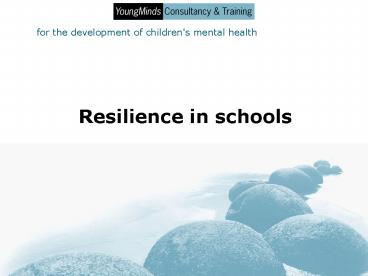Resilience in schools - PowerPoint PPT Presentation
1 / 17
Title:
Resilience in schools
Description:
The ability to bounce back' from adversity ... Sociable. Independent. Reflective (not impulsive) Ability to concentrate on schoolwork ... – PowerPoint PPT presentation
Number of Views:2507
Avg rating:3.0/5.0
Title: Resilience in schools
1
Resilience in schools
2
What is Resilience?
- The ability to bounce back from adversity
- The ability to withstand or recover quickly from
difficult conditions - An ability to recover from or adjust easily to
misfortune or change
3
Why is it important?
- Researchers have looked to answer 2 main
questions when studying resilience - Why is it that some children cope with adversity
(lifes ups and downs) much better than others? - What are the factors that lead to some children
being more resilient than others?
4
Risk Factors-Child
- Genetic influences
- Low IQ and learning disability
- Specific developmental delay
- Communication difficulty
- Difficult temperament
- Physical illness, especially if chronic and/or
neurological - Academic failure
- Low self-esteem
- Pearce (1993)
5
Risk factors- family
- Overt parental conflict
- Family breakdown
- Inconsistent or unclear discipline
- Hostile and rejecting relationships
- Failure to adapt to child's changing
developmental needs - Abuse - physical, sexual and/or emotional
- Parental criminality, alcoholism personality
disorder - Parental psychiatric illness
- Death loss - including loss of friendships
- Pearce (1993)
6
Risk factors- environmental
- Socio-economic disadvantage
- Homelessness
- Disaster
- Discrimination
- Other significant life events
- Pearce (1993)
7
Protective factors
- Researchers have identified a number of factors
that will help to protect a child and increase
their level of resilience
8
Individual factors
- Female
- Sense of competence and self efficacy
- Internal locus of control
- Empathy with others
- Problem-solving skills
- Communication skills
- Sociable
- Independent
- Reflective (not impulsive)
- Ability to concentrate on schoolwork
- Autonomy(girls)
- Emotional expressiveness(boys)
- Sense of humour
- Hobbies
- Willingness and capacity to plan
9
Family Factors
- Close bond with at least one person
- Nurturance and trust
- Lack of separations
- Lack of parental mental health or addiction
problems - Encouragement for expression of feelings(boys)
- Encouragement for autonomy(girls)
- Close grandparents
- Family harmony
- Sibling attachment
- Four or fewer children
- Sufficient financial and material resources
10
Community factors
- Neighbour and other non-kin support
- Peer contact
- Good school experiences
- Positive adult role models
- Daniel and Wassell, 2002
11
What does a resilient child look like?
- The International Resilience Project uses a list
of 15 items that indicate resilience in a child.
(Grotberg 1997) - The child has someone who loves him/her totally
(unconditionally) - The child has an older person outside the home
she/he can tell about problems and feelings - The child is praised for doing things on his/her
own - The child can count on his/her family being there
when needed - The child knows someone he/she wants to be like
12
- The child believes things will turn out all right
- The child does endearing things that make people
like her/him - The child believes in power greater than seen
- The child is willing to try new things
- The child likes to achieve in what he/she does
- The child feels that what she/he does makes a
difference in how things come out - The child likes himself/herself
- The child can focus on a task and stay with it
- The child has a sense of humour
- The child makes plans to do things
13
Further questions
- Now we know much more about risk and protective
characteristics for resilience in children and
young people, what does this mean for our
everyday practice and how do we build resilience
in schools?
14
A resilience based approach
- focuses on building a protective network around
children and young people - Offers an alternative framework for intervention
- The focus being on the assessment of potential
areas of strength within the childs whole system - Daniel and Wassell 2002
15
Why Schools
- More than any institution except the family,
schools can provide the environment and
conditions that foster resiliency in todays
youth and tomorrows adults (Henderson and
Milstein, 1996, p.2.). - Schools offer a wide range of opportunities to
boost resilience, including acting as a
complementary secure base, providing many
possibilities for developing self-esteem and
efficacy and opportunities for constructive
contact with peers and supportive adults - Emmy Werner found that apart from the immediate
family, a favourite teacher provided the most
positive adult for resilient children. The
teachers effects were more profound than just
simple academic development (Zimmerman, May 1994,
p.3).
16
Some Resources
- The School Years - Assessing and promoting
resilience in vulnerable children Daniel B and
Wassell S 2002 - A Guide to Promoting Resilience in Children
Strengthening the Human Spirit E Grotberg1995 - Healthy promoting Schools website
- Transitions in the Lives of Children and Young
People Resilience Factors - Tony Newman and Sarah Blackburn (Barnardo's
Policy, Research and Influencing Unit) 2006
17
Question
- As a group, look at some of the suggestions for
building resilience in schools. Discuss your
experience of where you have seen any of this
type of work taking place. - Choose up to 3 of the examples to feedback to the
larger group































